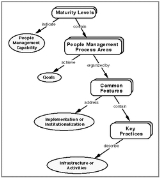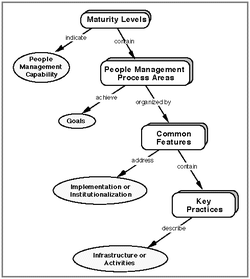
People Capability Maturity Model
Encyclopedia
People Capability Maturity Model (short names:People CMM, PCMM,P-CMM) is a maturity framework that focuses on continuously improving the management and development of the human assets of an organization. It describes an evolutionary improvement path from ad hoc, inconsistently performed practices, to a mature, disciplined, and continuously improving development of the knowledge, skills, and motivation of the workforce that enhances strategic business performance.
The People Capability Maturity Model (People CMM) is a framework that helps organizations successfully address their critical people issues. Based on the best current practices in fields such as human resources, knowledge management, and organizational development, the People CMM guides organizations in improving their processes for managing and developing their workforces. The People CMM helps organizations characterize the maturity of their workforce practices, establish a program of continuous workforce development, set priorities for improvement actions, integrate workforce development with process improvement, and establish a culture of excellence. Since its release in 1995, thousands of copies of the People CMM have been distributed, and it is used worldwide by organizations, small and large. First published in book form in 2001, it is in print in several editions worldwide, and a second edition was published in July of 2009.
The People CMMp consists of five maturity levels that establish successive foundations for continuously improving individual competencies, developing effective teams, motivating improved performance, and shaping the workforce the organization needs to accomplish its future business plans. Each maturity level is a well-defined evolutionary plateau that institutionalizes new capabilities for developing the organization's workforce. By following the maturity framework, an organization can avoid introducing workforce practices that its employees are unprepared to implement effectively.
The People CMM has been published in book form in numerous editions around the world.
 The People CMM document describes the People CMM, the practices that constitute each of its maturity levels, and information on how to apply it in guiding organizational improvements. It describes an organization's capability for developing its workforce at each maturity level. It describes how the People CMM can be applied as a standard for assessing workforce practices and as a guide in planning and implementing improvement activities.
The People CMM document describes the People CMM, the practices that constitute each of its maturity levels, and information on how to apply it in guiding organizational improvements. It describes an organization's capability for developing its workforce at each maturity level. It describes how the People CMM can be applied as a standard for assessing workforce practices and as a guide in planning and implementing improvement activities.
Version 2 of the People CMM has been designed to correct known issues in Version 1, which was released in 1995; to add enhancements learned from five years of implementation experience; and to integrate the model better with CMMI
and its IPPD extensions. The primary motivation for updating the People CMM was the error in Version 1 of placing team-building activities at Maturity Level 4. The authors made this placement based on substantial feedback that it should not be placed at Maturity Level 3, as it had been in early review releases. Experience has indicated that many organizations initiate formal development of workgroups while working toward Maturity Level 3. Thus, Version 2 of the People CMM initiates process-driven workgroup development at Maturity Level 3. This change is consistent with the placing of integrated teaming activities at Maturity Level 3 of the CMMI-IPPD.
The People Capability Maturity Model (People CMM) is a framework that helps organizations successfully address their critical people issues. Based on the best current practices in fields such as human resources, knowledge management, and organizational development, the People CMM guides organizations in improving their processes for managing and developing their workforces. The People CMM helps organizations characterize the maturity of their workforce practices, establish a program of continuous workforce development, set priorities for improvement actions, integrate workforce development with process improvement, and establish a culture of excellence. Since its release in 1995, thousands of copies of the People CMM have been distributed, and it is used worldwide by organizations, small and large. First published in book form in 2001, it is in print in several editions worldwide, and a second edition was published in July of 2009.
The People Capability Maturity Model
- Characterize the maturity of their workforce practices
- Set priorities for immediate action
- Integrate workforce development with process improvement
- Become an employer of choice
The People CMMp consists of five maturity levels that establish successive foundations for continuously improving individual competencies, developing effective teams, motivating improved performance, and shaping the workforce the organization needs to accomplish its future business plans. Each maturity level is a well-defined evolutionary plateau that institutionalizes new capabilities for developing the organization's workforce. By following the maturity framework, an organization can avoid introducing workforce practices that its employees are unprepared to implement effectively.
The People CMM has been published in book form in numerous editions around the world.
Structure of People CMM

Version 2 of the People CMM has been designed to correct known issues in Version 1, which was released in 1995; to add enhancements learned from five years of implementation experience; and to integrate the model better with CMMI
Capability Maturity Model Integration
Capability Maturity Model Integration is a process improvement approach whose goal is to help organizations improve their performance. CMMI can be used to guide process improvement across a project, a division, or an entire organization...
and its IPPD extensions. The primary motivation for updating the People CMM was the error in Version 1 of placing team-building activities at Maturity Level 4. The authors made this placement based on substantial feedback that it should not be placed at Maturity Level 3, as it had been in early review releases. Experience has indicated that many organizations initiate formal development of workgroups while working toward Maturity Level 3. Thus, Version 2 of the People CMM initiates process-driven workgroup development at Maturity Level 3. This change is consistent with the placing of integrated teaming activities at Maturity Level 3 of the CMMI-IPPD.
See also
- Capability Maturity ModelCapability Maturity ModelThe Capability Maturity Model is a development model that was created after study of data collected from organizations that contracted with the U.S. Department of Defense, who funded the research. This model became the foundation from which CMU created the Software Engineering Institute...
(CMM) - Capability Immaturity Model (CIMM)
- Capability Maturity Model IntegrationCapability Maturity Model IntegrationCapability Maturity Model Integration is a process improvement approach whose goal is to help organizations improve their performance. CMMI can be used to guide process improvement across a project, a division, or an entire organization...
(CMMI)

